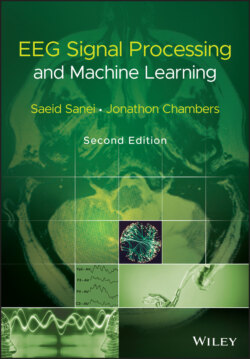Читать книгу EEG Signal Processing and Machine Learning - Saeid Sanei - Страница 26
2.2.4 Conditioning the Signals
ОглавлениеThe raw EEG signals have amplitudes of the order of μV and contain frequency components of up to 300 Hz. To retain the effective information the signals have to be amplified before the ADC and filtered, either before or after the ADC, to reduce the noise and make the signals suitable for processing and visualization. The filters are designed in such a way not to introduce any change or distortion to the signals. Highpass filters with cut‐off frequency of usually less than 0.5 Hz are used to remove the disturbing very low frequency components such as those of breathing. Conversely, high‐frequency noise is mitigated using lowpass filters with cut‐off frequency of approximately 50–70 Hz. Notch filters with the null frequency of 50 Hz are often necessary to ensure perfect rejection of the strong 50 Hz power supply. In this case the sampling frequency can be as low as twice the bandwidth as commonly used by most EEG systems. The commonly used sampling frequencies for EEG recordings are 100, 250, 500, 1000, and 2000 samples per second. The main artefacts can be divided into patient related (physiological) and system artefacts. The patient related or internal artefacts are body movement‐related, EMG, ECG (and pulsation), EOG, ballistocardiogram, and sweating. The system artefacts are 50/60 Hz power supply interference, impedance fluctuation, cable defects, electrical noise from the electronic components, and unbalanced impedances of the electrodes. Often in the preprocessing stage these artefacts are highly mitigated and the informative information is restored. Some methods for removing the EEG artefacts will be discussed in the related chapters of this book. Figure 2.11 shows a set of normal EEG signals affected by eye‐blinking artefact. Similarly, Figure 2.12 represents a multichannel EEG set with clear appearance of ECG signals over the electrodes in the occipital region.
Figure 2.10 A 4‐mm diameter Stentrode with electrode contacts within the stent structure.
In the following sections we highlight the most popular changes in EEG measurements which correlate with physiological and mental abnormalities in the brain.
